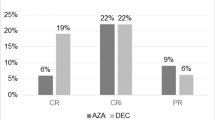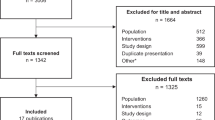Abstract
Standards of care for elderly acute myeloid leukemia (AML) patients unfit for intensive chemotherapy remain undefined. We aimed to compare outcomes of hypomethylating agent (HMA) therapy and intensive chemotherapy (IC) in elderly AML patients and identify the subgroup of patients who are eligible for HMA therapy. We reviewed data on the outcomes of 86 AML patients aged ≥ 65 years, who had undergone treatment between 2010 and 2015. These treatments included IC (25 patients, 29.1%) or therapy using HMA including azacitidine or decitabine (61 patients, 70.9%). The overall response rates were 32 and 19.7%, respectively. Median overall survival (OS) (8 vs. 8 months) and progression-free survival (PFS) (6 vs. 7 months) durations were similar in the two groups. Patients in the HMA group with less than 10% peripheral blood (PB) blasts achieved significantly better OS duration than patients in the IC group (P = 0.043). Patients in the IC group with PB blasts and bone marrow blast of ≥ 10 and ≥ 50%, respectively, achieved better PFS durations than the corresponding patients in the HMA group (P = 0.038). Multivariate analysis identified the hematologic improvement-platelet (HI-P) as an independent prognostic factor for survival in the HMA group (P = 0.005). Our results showed that HMA therapy and IC were associated with similar survival duration in elderly AML patients. This study was noteworthy because it assessed prognostic factors that would help to select elderly patients who could expect actual benefits from undergoing the different therapeutic options available, especially HMA therapy.


Similar content being viewed by others
References
Walter RB, Othus M, Borthakur G et al (2011) Prediction of early death after induction therapy for newly diagnosed acute myeloid leukemia with pretreatment risk scores: a novel paradigm for treatment assignment. J Clin Oncol 29(33):4417–4423. doi:10.1200/JCO.2011.35.7525
Juliussin G, Lazarevic V, Horstedt AS, Hagberg O, Hoglund M (2012) Acute myeloid leukemia in the real world: why population-based registries are needed. Blood 119(7):3890–3899. doi:10.1182/blood-2011-12-379008
Ziogas DC, Voulgarelis M, Zintzaras E (2011) A network meta-analysis of randomized controlled trials of induction treatments in acute myeloid leukemia in the elderly. Clin Ther 33:254–279. doi:10.1016/j.clinthera.2011.04.004
Burnett A, Wetzler M, Lowenberg B (2011) Therapeutic advances in acute myeloid leukemia. J Clin Oncol 29:489–494. doi:10.1200/JCO.2010.30.1820
Deschler B, de Witte T, Mertelsmann R, Lubbert M (2006) Treatment decision-making for older patients with high-risk myelodysplastic syndrome or acute myeloid leukemia: problems and approaches. Haematologica 91:1513–1522
Network NCC NCCN clinical practice guidelines in oncology. Acute Myeloid Leukemia Version 2.2016
Thomas X, LE Jeune C (2017) Treatment of elderly patients with acute myeloid leukemia. Curr Treat Options in Oncol 18:2–16. doi:10.1007/s11864-017-0445-5
Kantarjian HM, Thomas XG, Dmoszynska A et al (2012) Multicenter, randomized, open-label, phase III trial of decitabine versus patient choice, with physician advice, of either supportive care or low-dose cytarabine for the treatment of older patients with newly diagnosed acute myeloid leukemia. J Clin Oncol 30:2670–2677. doi:10.1200/JCO.2011.38.9429
Dombert H, Seymour JF, Butrym A et al (2015) International phase 3 study of azacitidine vs conventional care regimens in older patients with newly diagnosed AML with >30% blasts. Blood 126:291–299. doi:10.1182/blood-2015-01-621664
Cheson BD, Greenberg PL, Bennett JM et al (2006) Clinical application and proposal for modification of the International Working Group (IWG) response criteria in myelodysplasia. Blood 108:419–425. doi:10.1182/blood-2005-10-4149
Howlader NNA, Krapcho M, Garshell J et al (2013) SEER cancer statistics review 1975–2010. Bethesda, National Cancer Institute
Jabbour EJ, Estey E, Kantarjian HM (2006) Adult acute myeloid leukemia. Mayo Clin Proc 81:247–260
Al-Ali HK, Jaekel N, Niederwieser D (2014) The role of hypomethylating agents in the treatment of elderly patients with AML. J Geriatr Oncol 5:89–105. doi:10.1016/j.jgo.2013.08.004
Fenaux P, Mufti GJ, Hellstrom-Lindberg E et al (2010) Azacitidine prolongs overall survival compared with conventional care regimens in elderly patients with low bone marrow blast count acute myeloid leukemia. J Clin Oncol 28:562–569. doi:10.1200/JCO.2009.23.8329
Sekeres MA, Elson P, Kalaycio ME et al (2009) Time from diagnosis to treatment initiation predicts survival in younger, but not older, acute myeloid leukemia patients. Blood 113:28–36. doi:10.1182/blood-2008-05-157065
Lestag E, Ayari S, Chevallier P et al (2011) 5-azacytidine (AZA) compared to intensive chemotherapy in elderly acute myeloid leukemia (AML) patients: results of a retrospective single centre matched analysis. Blood 118:3620
Alfonso QC, Farhad R, Theresa LD et al (2012) Epigenetic therapy is associated with similar survival compared with intensive chemotherapy in older patients with newly diagnosed acute myeloid leukemia. Blood 120:4840–4845. doi:10.1182/blood-2012-06-436055
Krug U, Rollig C, Koschmieder A et al (2010) Complete remission and early death after intensive chemotherapy in patients aged 60 years or older with acute myeloid leukaemia: a web-based application for prediction of outcomes. Lancet 376:2000–2008. doi:10.1016/S0140-6736(10)62105-8
Chen CC, Yang CF, Yang MH et al (2005) Pretreatment prognostic factors and treatment outcome in elderly patients with de novo acute myeloid leukemia. Ann Oncol 16:1366–1373
Pleyer L, Burgstaller S, Girschikofsky M et al (2014) Azacitidine in 302 patients with WHO-defined acute myeloid leukemia: results from the Austrian Azacitidine Registry of the AGMT-Study Group. Ann Hematol 93(11):1825–1838. doi:10.1007/s00277-014-2126-9
Thepot S, Itzykson R, Seegers V et al (2014) Azacitidine in untreated acute myeloid leukemia: a report on 149 patients. Am J Hematol 89(4):410–416. doi:10.1002/ajh.23654
Mayer J, Arthur C, Delaunay J et al (2014) Multivariate and subgroup analyses of a randomized, multinational, phase 3 trial of decitabine vs treatment choice of supportive care or cytarabine in older patients with newly diagnosed acute myeloid leukemia and poor- or intermediate-risk cytogenetics. BMC Cancer 14:69. doi:10.1186/1471-2407-14-69
Wheatley K, Brookes CL, Howman AJ et al (2009) Prognostic factor analysis of the survival of elderly patients with AML in the MRC AML11 and LRF AML 14 trials. Br J Haematol 145:598–605. doi:10.1111/j.1365-2141.2009.07663.x
Kantarjian H, O Brien S, Cortes J, et al (2006) Results of intensive chemotherapy in 998 patients age 65 years or older with acute myeloid leukemia or high-risk myelodysplastic syndrome: predictive prognostic models for outcome. Cancer 106:1090–1098
Rollig C, Thiede C, Gramatzki M et al (2010) A novel prognostic model in elderly patients with acute myeloid leukemia: results of 909 patients entered into the prospective AML96 trial. Blood 116:971–978. doi:10.1182/blood-2010-01-267302
Acknowledgments
We thank all centers that participated in this study.
Author information
Authors and Affiliations
Consortia
Corresponding author
Ethics declarations
Conflict of interest
This work was supported by clinical research grant from Pusan National University Hospital in 2017.
Ethical approval
All procedures involving human participants were performed in accordance with the ethical standards of either the institutional or the national research committee, or of both, and with the 1964 Helsinki declaration and its later amendments or comparable ethical standards.
Informed consent
Informed consent was obtained from all individual participants included in the study.
Rights and permissions
About this article
Cite this article
Oh, SB., Park, SW., Chung, JS. et al. Therapeutic decision-making in elderly patients with acute myeloid leukemia: conventional intensive chemotherapy versus hypomethylating agent therapy. Ann Hematol 96, 1801–1809 (2017). https://doi.org/10.1007/s00277-017-3104-9
Received:
Accepted:
Published:
Issue Date:
DOI: https://doi.org/10.1007/s00277-017-3104-9




